Fact Sheet 2012–3037
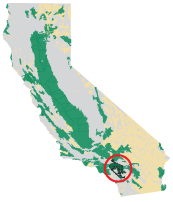
The Upper Santa Ana Watershed Study UnitThe Upper Santa Ana Watershed study unit covers approximately 1,000 square miles. Within this study unit, the San Jacinto and Elsinore groundwater basins each constituted a study area, and the nine subbasins of the Upper Santa Ana Valley groundwater basin were grouped into four additional study areas based on geography: Bunker Hill/Cajon/Rialto- Colton; Cucamonga/Chino; Riverside-Arlington/Temescal; and Yucaipa/San Timoteo (Kent and Belitz, 2009). 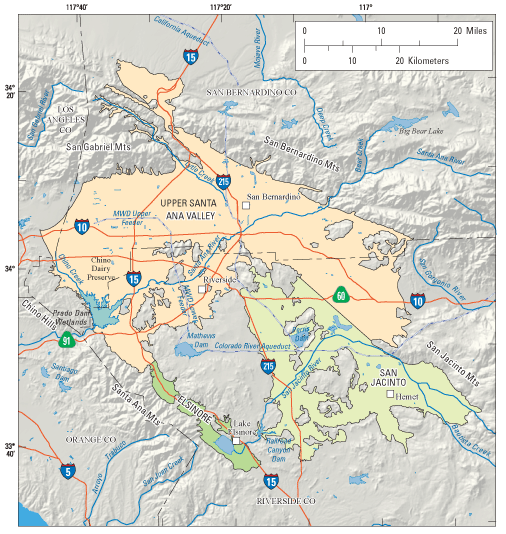
The study unit has hot, dry summers and cool, moist winters. Average annual rainfall ranges from 10 to 24 inches in the valleys and from 24 to 48 inches in the mountains within and surrounding the study unit. The Santa Ana River, with its headwaters in the San Bernardino Mountains, is the longest river in Southern California and flows southwestward through the Upper Santa Ana Valley. Streamflow in the Santa Ana River varies seasonally; the highest flows are generally in the winter and spring. In the dry season, most streamflow in the Santa Ana River consists of tertiary treated wastewater (Belitz and others, 2004). Most aquifers of the study unit are unconfined, with some confined groundwater in the Bunker Hill and Chino Subbasins and the eastern part of the San Jacinto Basin. Groundwater flow in most of the study unit is affected by numerous faults cutting the alluvial sediments. The primary aquifers of the Upper Santa Ana Watershed study unit are defined as those parts of the aquifers underlying the study unit and corresponding to the perforated intervals of the wells listed in the California Department of Public Health (CDPH) database. Public-supply wells typically are drilled to depths of 200 to 650 feet, consist of solid casing from the land surface to depths of about 175 to 500 feet, and then are perforated below the solid casing. Water quality in the primary aquifers may differ from that in the shallower and deeper parts of the aquifer system. Land use in the study unit is approximately 44 percent (%) natural, 21% agricultural, and 35% urban. Most of the land use adjacent to the study unit is natural and consists of steep mountains or hills generally covered by forest or chaparral. Recharge to the groundwater system occurs through direct infiltration, return irrigation flow, and stream-channel infiltration from the Santa Ana and San Jacinto Rivers and their tributaries, and from numerous engineered recharge facilities operating in the study unit. The primary sources of discharge are water pumped for municipal supply, evaporation from areas with a shallow depth to water, and discharge to streams. 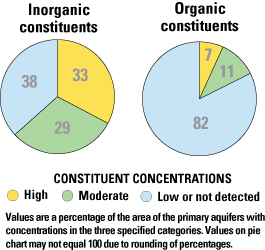
Overview of Water QualityGAMA’s Priority Basin Project evaluates the quality of untreated groundwater. However, for context, benchmarks established for drinking-water quality are used for comparison. Benchmarks and definitions of high, moderate, and low concentrations are discussed in the inset box on page 3. Many inorganic constituents occur naturally in groundwater. The concentrations of inorganic constituents can be affected by natural processes as well as by human activities. In the Upper Santa Ana Watershed study unit, one or more inorganic constituents were present at high concentrations in about 33% of the primary aquifers and at moderate concentrations in about 29% of the primary aquifers. Organic constituents can be found in products used in the home, business, industry, or agriculture, and can enter the environment through normal usage, spills, or improper disposal. In this study unit, one or more organic constituents were present at high concentrations in about 7% of the primary aquifers and at moderate concentrations in about 11%. RESULTS: Groundwater Quality in the Upper Santa Ana Watershed Study Unit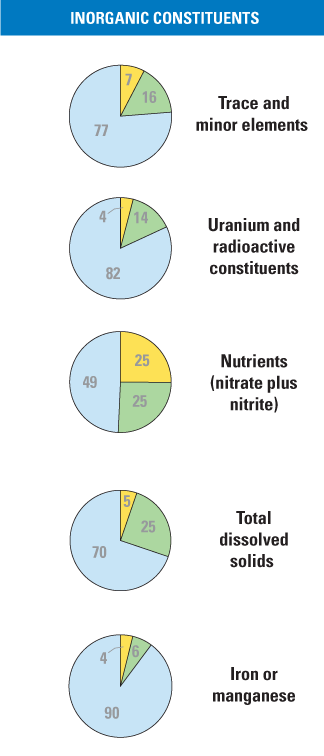
Inorganic Constituents with Human-Health BenchmarksTrace and minor elements are naturally present in the minerals in rocks and soils, and in the water that comes into contact with those materials. In the Upper Santa Ana Watershed study unit, one or more of the trace elements were present at high concentrations in about 7% of the primary aquifers, on an areal basis. Arsenic, boron, and molybdenum were the trace elements that most frequently occurred at high concentrations. Aluminum, fluoride, lead, uranium, and vanadium also were detected at high concentrations, but each of them were detected at high concentrations in less than 2% of the primary aquifers. Radioactivity is the emission of energy or energetic particles during spontaneous decay of unstable atoms. Most of the radioactivity in groundwater comes from the decay of naturally occurring isotopes of uranium and thorium in minerals in the aquifer sediment. Gross alpha radioactivity, uranium, or radium-228 occurred at high levels in about 4% of the primary aquifers, and at moderate levels in about 14%. Nutrients, such as nitrate and nitrite, can be naturally present at low concentrations in groundwater. High and moderate concentrations generally occur as a result of human activities, such as applying fertilizer to crops. Livestock, when in concentrated numbers, and septic systems also produce nitrogenous waste that can leach into groundwater. Nitrate plus nitrite was present at high concentrations in about 25% of the primary aquifers, and also at moderate concentrations in about 25% of the primary aquifers. Inorganic Constituents with Non-Health Benchmarks(Not included in water-quality overview charts shown on the front page)Some constituents can affect the aesthetic properties of water, such as taste, color, and odor, or can create nuisance problems, such as staining and scaling. The State of California has a recommended limit and an upper limit for total dissolved solids (TDS) in drinking water. Groundwater naturally contains TDS as a result of the weathering and dissolution of minerals in soils. In the Upper Santa Ana Watershed study unit, TDS was present at high concentrations (greater than the upper limit) in about 5% of the primary aquifers. About 25% of the primary aquifers had moderate TDS concentrations (between the recommended and upper limit). Iron and manganese are naturally occurring elements, but anoxic conditions (low amounts of dissolved oxygen) in groundwater can result in release of iron and manganese from minerals into groundwater. Iron or manganese, or both, were present at high concentrations in about 4% of the primary aquifers. Iron or manganese, or both, were present at moderate concentrations in about 6% of the primary aquifers and at low concentrations in about 90%. 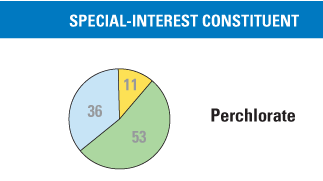
Perchlorate(Not included in water-quality overview charts shown on the front page)Perchlorate, an inorganic constituent, is of special interest in California because it has recently been found in drinking-water supplies. Perchlorate in groundwater is monitored by the California Department of Public Health (http://www.cdph.ca.gov). It is an ingredient in rocket fuel, fireworks, safety flares, and other products, may be present in some fertilizers, and also occurs naturally at low concentrations in groundwater. Perchlorate was present at high concentrations in about 11% of the primary aquifers, and at moderate concentrations in about 53% of the primary aquifers. 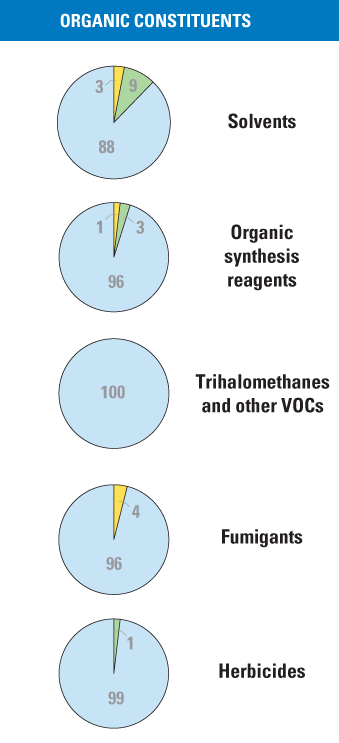
Organic ConstituentsThe Priority Basin Project uses laboratory methods that can detect low concentrations of volatile organic compounds (VOCs) and pesticides, far below human-health benchmarks. The presence of VOCs and pesticides detected at these low concentrations can be used to trace water from the landscape into the aquifer system. Volatile Organic Compounds with Human-Health BenchmarksVOCs are in many household, commercial, industrial, and agricultural products and are characterized by their tendency to volatilize (evaporate) into the air. Solvents are used for a number of purposes, including manufacturing and cleaning. In the Upper Santa Ana Watershed study unit, solvents were present at high concentrations in about 3% of the primary aquifers. The solvents found at high concentrations were tetrachloroethene (PCE), trichloroethene (TCE), and carbon tetrachloride. Solvents were present at moderate concentrations in about 9% of the primary aquifers, and were low or not detected in about 88%. Organic synthesis reagents are compounds used in the manufacture or preparation of organic compounds. One organic synthesis reagent, 1,1-dichloroethene, was found at high concentrations in about 1% of the primary aquifers, and at moderate concentrations in about 3%. Other VOCs include gasoline additives, trihalomethanes, and refrigerants. No gasoline additives, trihalomethanes, or refrigerants were detected at high or moderate concentrations in the Upper Santa Ana Watershed study unit. Pesticides with Human-Health BenchmarksPesticides are applied to crops, gardens, lawns, around buildings, and along roads to help control unwanted vegetation (weeds), insects, fungi, and other pests. In the Upper Santa Ana Watershed study unit, insecticides were only detected at low concentrations in the primary aquifers. However, 1,2-dibromo-3-chloropropane (DBCP), a fumigant that was used to control crop damage from nematode worms prior to 1977, was found at high concentrations in about 4% of the primary aquifers. Herbicides were not detected at high concentrations in the primary aquifers, but the herbicide atrazine was detected at moderate concentrations in about 1% of the primary aquifers. All other pesticides, when detected, were at low concentrations. BENCHMARKS FOR EVALUATING GROUNDWATER QUALITY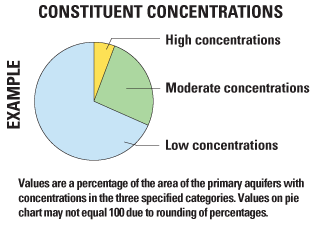
GAMA’s Priority Basin Project uses benchmarks established for drinking water to provide context for evaluating the quality of untreated groundwater. After withdrawal, groundwater may be disinfected, filtered, mixed, and exposed to the atmosphere before being delivered to consumers. Federal and California regulatory benchmarks for protecting human health (Maximum Contaminant Level, MCL) were used for the evaluation when available. Otherwise, non-regulatory benchmarks for protecting aesthetic properties (Secondary Maximum Contaminant Level, SMCL), such as taste and odor, and non-regulatory benchmarks for protecting human health (Notification Level, NL, and Lifetime Health Advisory, HAL) were used. High, moderate, and low concentrations are defined relative to benchmarksConcentrations are considered high if they are greater than a benchmark. For inorganic constituents, concentrations are moderate if they are greater than one-half of a benchmark. For organic and special-interest constituents, concentrations are moderate if they are greater than one-tenth of a benchmark; this lower threshold was used because organic constituents generally are less prevalent and have smaller concentrations relative to benchmarks than inorganic constituents. Low includes nondetections and values less than moderate concentrations. Methods for evaluating water quality are discussed in Kent and Belitz (2012). Anthropogenic Constituents in the Upper Santa Ana Watershed Study UnitIn California, high concentrations of organic constituents introduced by human (anthropogenic) activity generally occur in less than 1% of the aquifer system (Belitz and Landon, 2010). However, in the Upper Santa Ana Watershed and nearby San Gabriel and San Fernando Valleys, high concentrations of organic constituents (greater than health-based thresholds) are present in nearly 7% of the primary aquifers (Kent and Belitz, 2012). Solvents, including tetrachloroethene (PCE), trichloroethene (TCE), and carbon tetrachloride, were detected at high concentrations in about 3% of the primary aquifers. 1,2-Dibromo-3-chloropropane (DBCP), a fumigant, was detected at high concentrations in about 4% of the primary aquifers. 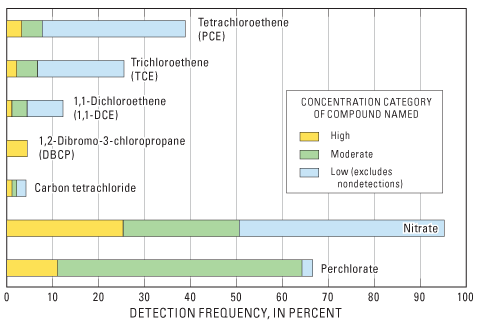
Nitrate and perchlorate are inorganic chemicals with natural and anthropogenic sources, but in the Upper Santa Ana Watershed, both enter groundwater mostly through human activities (Belitz and others, 2004). Anthropogenic sources of nitrate include agriculture (fertilizer and livestock waste), effluent from wastewater treatment plants, and septic systems (Belitz and others, 2004). Nitrate was present at high concentrations in about 25% of the primary aquifers in the Upper Santa Ana Watershed study unit. Nationwide, anthropogenic sources of perchlorate in groundwater include residues from road flares, explosives, and fireworks, along with accidental releases from perchlorate manufacturing. In addition to these potential sources, perchlorate was incidentally introduced to the Upper Santa Ana Watershed in the early to mid-1900s from nitrate fertilizer that was imported for use in citrus groves (Santa Ana Regional Water Quality Control Board, 2004). High concentrations of nitrate and perchlorate are more prevalent in the Upper Santa Ana Watershed than in other California study units. Priority Basin AssessmentsGAMA’s Priority Basin Project (PBP) assesses water quality in that part of the aquifer system used for drinking water, primarily public supply. Water quality in shallower and deeper parts may differ from that in the primary aquifers. GAMA’s Domestic Well Project assesses water quality in the shallower parts of the aquifer system. Ongoing assessments are being conducted in more than 120 basins throughout California. The PBP assessments are based on a comparison of constituent concentrations in untreated groundwater with benchmarks established for the protection of human health and for aesthetic concerns. The PBP does not evaluate the quality of drinking water delivered to consumers. The PBP uses two scientific approaches for assessing groundwater quality. The first approach uses a network of wells to statistically assess the status of groundwater quality. The second approach combines water-quality, hydrologic, geographic, and other data to help assess the factors that affect water quality. In the Upper Santa Ana Watershed study unit, data were collected by the PBP in 2006–2007 and from the CDPH database for 2003–2006. The PBP includes chemical analyses not generally available as part of regulatory compliance monitoring, including measurements at concentrations much lower than human-health benchmarks, and measurement of constituents that can be used to trace the sources and movement of groundwater. SELECTED REFERENCESBelitz, Kenneth, Hamlin, S.N., Burton, C.A., Kent, Robert, Fay, R.G., and Johnson, Tyler, 2004, Water quality in the Santa Ana Basin, California, 1999–2001: U.S. Geological Survey Circular 1238, 37 p. (Also available at https://pubs.usgs.gov/circ/2004/1238/.) Belitz, Kenneth, and Landon, M.K., 2010, Groundwater quality in the Central Eastside San Joaquin Valley, California: U.S. Geological Survey Fact Sheet 2010-3001, 4 p. (Also available at https://pubs.usgs.gov/fs/2010/3001/.) California Department of Water Resources, 2003, California’s groundwater: California Department of Water Resources Bulletin 118, 246 p. (Also available at http://www.water.ca.gov/groundwater/bulletin118/update2003.cfm.) Kent, Robert, and Belitz, Kenneth, 2009, Ground-water quality data in the Upper Santa Ana Watershed Study Unit, November 2006–March 2007—Results from the California GAMA Program: U.S. Geological Survey Data Series 404, 116 p. (Also available at https://pubs.usgs.gov/ds/404.) Kent, Robert, and Belitz, Kenneth, 2012, Status of groundwater quality in the Upper Santa Ana Watershed, November 2006–March 2007—California GAMA Priority Basin Project: U.S. Geological Survey Scientific Investigations Report 2012-5052, 88 p. (Also available at https://pubs.usgs.gov/sir/2012/5052/.) Santa Ana Regional Water Quality Control Board, 2004, Senate Select Committee on Perchlorate Contamination—Status of cleanup efforts in the Inland Empire, February 27, 2004, presentation by Gerard J. Thibeault, Executive Officer California Regional Water Quality Control Board, Santa Ana Region, accessed December 8, 2010, at http://www.waterboards.ca.gov/rwqcb8/water_issues/programs/perchlorate/docs/2004_feb_27_senate_hearing.pdf. |
First posted July 17, 2012 For additional information contact: Technical reports and hydrologic data collected for the GAMA PBP Program may be obtained from: GAMA Project Chief GAMA Program Unit Part or all of this report is presented in Portable Document Format (PDF); the latest version of Adobe Reader or similar software is required to view it. Download the latest version of Adobe Reader, free of charge. |
Kent, Robert, and Belitz, Kenneth, 2012, Groundwater quality in the Upper Santa Ana Watershed study unit, California: U.S. Geological Survey Fact Sheet 2012-3037, 4 p.